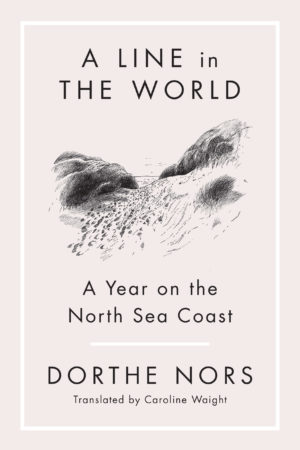A Line in the World
by Dorthe Nors, translated by Caroline Waight
reviewed by Laura Albritton
With A Line in the World, Danish novelist and short story writer Dorthe Nors turns her hand to nonfiction. Ably translated from the Danish by Caroline Waight, these fourteen essays trace Nors’s various journeys along Denmark’s North Sea shore over the course of a year. A Line in the World is not a straightforward narrative intended for armchair travelers, despite the appealing black and white line drawings by Signe Parker that appear before each essay. Instead, in each essay Nors makes thoughtful connections between the rugged, if beautiful, landscape and several subjects: her own past, Danish and international history, environmental concerns, and the societal position of women. For the most part, A Line in the World reads as a cohesive whole and the essays as connected chapters with recurring themes.
With the western littoral landscape acting as a unifying element, the essays take the reader on an intellectual, historical, and psychological journey with a rich array of experience and detail. In “The Line,” the collection’s first essay, the author recounts her family’s connection to the coast of Jutland, and how as an adult in Copenhagen, she longed to replace the urban cityscape with a wild landscape: “I want a north-west wind, fierce and hard. I want trees so battered and beaten they’re crawling over the ground.” There is an intensity to Nors’s writing that one encounters from the very first pages, as when she comments on the lack of female perspective in historical accounts about Denmark’s wilderness: “Women’s relationships with the landscape were relatively undocumented. [ … ] But now I have claimed the right to see and to describe.” The tone can be fierce, almost defiant, as if she is both wrestling with her subject matter and laying down a challenge to her readers. “I’m not looking for some trumped-up truth about a particular piece of geography,” she warns us, quashing any expectation of a conventional chronicle.
With some of the essays, you have to trust in Nors’s writerly ability to pull all the disparate reflections and ostensible digressions together by the last paragraph. In “Magnets,” she writes about the migrations of birds that “remember the landscape far below them. As though the landscape were a readable language.” Migratory birds partially orient themselves through “small hair cells containing a magnetic substance,” we learn. We also learn that when Nors was a child, her father shot a common snipe and had it stuffed; why the stuffed bird is included is initially unclear, although it adds a tinge of melancholy. Later, she identifies one of the “pit stops” for migrating birds as the remote intertidal Wadden Sea along which she once lived. She describes the people who seek “a kind of shelter” on Denmark’s outer edge, but strips away any romantic notions about living here: “The place was supposed to improve your life, but it simply trapped you in the life you already had, only now without a filter: your demons came with you.” When a poet visits her by the Wadden Sea, Nors finds her colleague’s idealistic view of the area aggravating, and to disillusion her, invents a frightening story about this sea—which, indeed, scares the other writer into leaving. One wonders why Nors reveals this ungenerous behavior; is it a moment of self-reproach or simply honesty? By the end of the piece, Nors returns to the snipe, the dead stuffed bird that peered down on her family home when she was young. An animal deprived of its ability to navigate the world. This provokes a final epiphany: “I felt grief for the losses that have been and the losses to come.” She wishes that she could freeze time, just as her father had frozen the bird in time by shooting it and stuffing it, yet acknowledges, “we can’t stop time. We can’t escape the force that draws us through the world. We have magnets in our bodies.”
The essay “The Shortest Night” similarly incorporates observation and memory, daring the reader to find patterns or meaning. In Denmark, people celebrate Midsummer night with bonfires and burn a witch in effigy. Nors notes that the present-day tradition of setting fire to “a female doll” could be interpreted as “a cosy custom”—or perhaps something more troubling. She also describes the appealing lushness of nature this time of year. Certain particulars in the essay—the sight of a young doe with its mother, the remembrance of her brother getting lost as a child, an injured man—seem to allude to the quality of vulnerability. Contrasted with these are elements of enduring strength, such as eight lighthouses that guard the Danish coast and stalwart grandmothers with “tattoos and big, wrinkled cleavages” who swim offshore. Even in the heart of summer, though, there are intimations of winter, as nature’s cycle continues. The essay nears its conclusion with a barbed, if nuanced, comment: “Tonight we burn those whose instincts don’t conform, but we are civilized now and set fire only to symbols.”
In this rather unusual collection, which intertwines subjects as disparate as Viking history, modern surfing, and ancient church frescoes, Nors has written a powerful, authoritative masterpiece. A sometimes stern work, A Line in the World introduces North American readers to a surprising new world and a new way of seeing things.
Published on December 27, 2022

